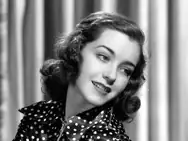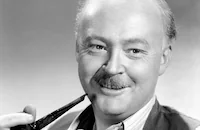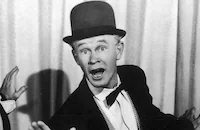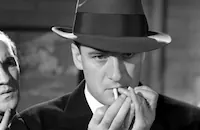Unholy Partners

Brief Synopsis
Cast & Crew
Mervyn Leroy
Edward G. Robinson
Edward Arnold
Laraine Day
Marsha Hunt
William T. Orr
Film Details
Technical Specs

Synopsis
At the end of World War I, veteran Bruce Corey wants to quit his newspaper editing job at The New York Sentinel to start his own paper. With the encouragement of his secretary, Miss Cronin, Corey tries to raise $300,000 but is unsuccessful until crooked gambler Merrill Lambert offers to give him half, hoping to divert Corey from writing damaging articles about him. Lambert suggests a double or nothing bet for the other half, and Corey wins in one roll of the dice.
Even though Lambert tries to have Corey robbed to get his money back, he agrees to become an equal, but silent, partner in the strictly legitimate New York Mercury . Corey hires most of his pals from the Sentinel , including "Cronie" and army buddy Tommy Jarvis, then decides to drum up business by doing some behind-the-scenes meddling and creating provocative "shock" headlines. Despite Cronie's advice that the paper could be used for higher purposes, by the late 1920s, the Mercury 's sensational news reporting has made it very successful. One story, about the murder of showgirl Hope Keane is something that Lambert wants to stop as one of his men, Georgie Peloti, is the murderer.
At the same time, Tommy, who has changed his name because years ago his father was involved in a highly publicized murder scandal, is sick of headline chasing and tells Corey he wants to quit. Lambert goes to Corey's apartment, accompanied by aspiring actress Gail Fenton, to whom Tommy is immediately attracted. During a brief business meeting, Lambert suggests that Corey spends too much time on stories like the Keane murder and warns him not to implicate Peloti. After Gail and Lambert leave for a backstage party to which the press are not invited, Corey decides to crash the party with Tommy. When Lambert learns that Corey is at the party, which is attended by the high and mighty, he again warns him, saying "when I tell you not to print something, you don't print it." Corey disregards the warning and calls his night editor, Michael Z. Reynolds, telling him to print a headline story about a police raid on the party, then calls Inspector Brody asking him to call a raid to stop the illegal drinking. Corey then leaves to wait for the raid, but the smitten Tommy stays to hear Gail sing.
The next day, while Corey gloats, Mike reads the Sentinel and learns that Tommy was arrested in the raid. Because the story reveals his real name and delves into the family scandal, Tommy wants to leave New York, but first goes with Corey to a meeting with Lambert. Lambert is unsuccessful in his attempt to win back the paper using a crooked deck of cards, then, when Corey and Tommy are leaving, Gail arrives and acts very coldly, angering Tommy into staying with the Mercury . Corey now decides to investigate Lambert's supposedly legitimate insurance business, while at the same time backing French flyer Molyneaux's trans-Atlantic flight. He hopes to protect Tommy by sending him with Molyneaux, but Tommy has already started to investigate on his own by sneaking into Lambert's apartment.
While there, he finds a gambling marker for $50,000 from Gail's father Clyde, backed by a life insurance policy made out to Lambert. When Lambert comes home, Tommy manages to slip away, but is identified by the doorman. Tommy then goes to the Fenton apartment and tries to talk him into exposing Lambert. When Fenton learns that Gail has been seeing Lambert to help him, he tells Tommy that he will confess everything. After Tommy and Gail reveal their feelings for each other, he calls Corey, who pretends to be angry and orders him down to the paper. On the way, Tommy is kidnapped by one of Lambert's men. The next day, Corey calls Lambert and arranges a meeting. A worried Cronie runs after Corey and when she starts to cry, he finally admits his feelings. Just before he leaves, he says that they will get married the next day.
At the meeting, Lambert says that he will turn Tommy loose only if Corey signs the paper over to him. A scuffle over a gun then ensues and Lambert is killed, after which Corey forces one of Lambert's henchman to order Tommy's release. Later, a despondent Corey goes to Cronie's place and tells her about Lambert. Knowing that they cannot now marry, Cronie goes with Corey to an airfield outside New York. On the way, he dictates a letter of confession to Inspector Brody and gives her instructions on what to do for Fenton and the others who were victims of Lambert's insurance extortion scheme. At the airfield, Corey reveals that he is joining Molyneaux on the cross-Atlantic flight. She wants him to stay and fight, but Corey, afraid that it might ruin the paper, tells her that she and Tommy should take over.
After the plane takes off, Cronie throws her dictation away and returns to the Mercury to await news of the flight. Word finally comes through that Molyneaux was rescued after his plane went down, but Corey was lost in the Atlantic. When Tommy asks Cronie to recount what Corey talked about before he left, she says only that he wanted Tommy to get behind the editor's desk, and the two start to work on Corey's final story.

Director

Mervyn Leroy
Cast

Edward G. Robinson

Edward Arnold

Laraine Day

Marsha Hunt

William T. Orr

Don Beddoe

Walter Kingsford

Charles Dingle

Charles Halton
Joseph Downing

Clyde Fillmore
Emory Parnell

Don Costello

Marcel Dalio
Robert Homans
Frank Faylen

William Benedict
Charles B. Smith
Marvin Stephens
Tom Seidel
Charles Sherlock
Marte Faust
Larry Clifford
Gertrude Bennett
Frank Dawson
George Ovey
Tom O' Rourke
Al Hill
Jay Novello
John Dilson
Billy Mann
Ann Morrison
Lester Scharff
June Maccloy
Lorraine Krueger

Natalie Thompson
Florine Mckinney
Charles Jordan
Jim Spencer

Ray Teal

Elliott Sullivan
Ann Pennington
William Edmunds
Frank Darien
Joe Devlin
Dick Keene

Lee Phelps
Lester Dorr
Frank Mills
Milton Kibbee
Buster Slaven
Crew
Daniele Amfitheatrof
Earl Baldwin
George Barnes
Bartlett Cormack
Duffy Cornell
Henry Creamer
Cedric Gibbons
Lennie Hayton
Wally Heglin
Harold F. Kress
Turner Layton
Mervyn Leroy
Samuel Marx
Urie Mccleary
Lesser Samuels
Douglas Shearer
Al Shenberg
Al Siegel
David Snell
Edwin B. Willis

Film Details
Technical Specs

Articles
Unholy Partners -
By Richard Harland Smith

Unholy Partners -
Quotes
Trivia
Notes
The film's working titles were New York Story and The New York Story. The Daily Variety review for the Glendale, CA press preview of the film lists a running time of 108 minutes, but all other reviews list a running time of 94 minutes. Although the CBCS credits actor Charles Cane with the role of "Inspector Brody," the role was actually played by Robert Homans. According to Hollywood Reporter news items, William T. Orr was borrowed from Warner Bros. for the film and George Barnes was borrowed from David O. Selznick's company. A news item in Hollywood Reporter also noted that singer Connie Russell was to appear in the picture, but her appearance in the released film has not been confirmed.















